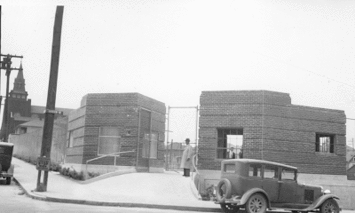
Seattle voters, if not the city’s newspapers, were strong supporters of Franklin Roosevelt and the New Deal in the 1930s and 1940s. As in many parts of the country, New Deal programs had a profound effect on Seattle and Washington state.
Seattle was a city dependent on industry and trade, and was hard hit by the Great Depression. The most famous and highly visible manifestation was the creation of a large shantytown worker settlement called Hooverville, spurred by the Unemployed Citizen’s League located on city land just south of downtown (where giant football and baseball stadiums are now!). The city burned it down after a week, the workers rebuilt it, the city burned it down again, and it was again rebuilt, this time with tin roofs. It was occupied until the end of the Depression. Its first mayor was a Jesse Jackson, who served as liaison to City Hall. A special census of 1934 counted 632 residents in 490 dwellings.
Even before then, Seattle and the state of Washington were already infamous for their radicalism, having spawned the only general strike in the nation’s history (1919), and the Centralia and Everett massacres, (1916, 1919) in which company goons fought with IWW (International Workers of the World) workers. Seattle also had an early history of public ownership, notably municipal power starting in 1902.
Not surprisingly, then, the prospect of federal-sponsored programs, jobs and some constraints placed against the perceived excesses of Big Capital was highly appealing and resulted in huge victories for Roosevelt and the Democrats in 1932, 1936 and 1940. In 1916, Anna Louise Strong, a communist, was elected to the Seattle School Board. Indeed, James Farley famously referred to “the 47 states and the soviet of Washington.” Seattle and Washington’s most successful and powerful political leader, Warren Magnuson, began his congressional career in 1936 from Seattle’s first district, and remained an unreconstructed New Dealer until his retirement from the Senate in 1981.
Another powerful figure was Dave Beck, who took over the local Teamster’s Union in 1936. Beck played a critical role in forging a less confrontational relation to capital than the more radical Harry Bridges of the Longshoremen.
Within the City of Seattle and suburbs, the WPA left an enduring legacy: bridges and retaining walls and drainage systems, parks and playgrounds, roads and trails, sewers, recreational facilities and programs, sewing for the needy, airports, streetcars, low income housing, and programs for musicians, artists and writers. For example the Federal Artist Project employed the well-known artists Kenneth Callahan and Morris Graves.
New Deal activities across the rest of the state were even wider and larger in scope. The greatest New Deal project by far was the Bonneville Power Administration, the Bureau of Reclamation’s construction of dams along the Columbia, culminating in the giant Grand Coulee Dam that drove the development of the Columbia Basin irrigation project, the nation’s largest. Seattle City Light’s J.D. Ross became the first director of Bonneville Power.
The WPA and the CCC (Civilian Conservation Corps – also known as the “forest army”) also completed hundreds of less spectacular but amazingly successful and lasting projects in the national forests and parks, and communities across the state. Perhaps most amazing was the government’s direct sponsorship of several rural utopian communities.
Today, although the real liberal voices of the New Deal era are now gone, the Seattle region remains somewhat “left” by national standards. But its radical, egalitarian soul has been largely lost. In 1975 Seattle was one of the nation’s most egalitarian cities, a legacy of the New Deal and its powerful, well-paid blue collar economy. Today it is now one of the most unequal!
Of course, this does not stop the local establishment and media from viewing itself as “progressive.” In 2008, there are no Republicans on the Seattle City Council, and no Republican from any Seattle district and few that hail from suburban districts in the Washington state legislature.
But the meaning of “progressive” today is utterly foreign to what it connoted in New Deal days. The metropolis is very highly planned, under the Growth Management Act, but the goals and policies are entirely by and for the affluent professional class: subsidies of opera houses, stadiums, replacement of public housing by “integrated developments” with high shares of market rate units. There’s an unfortunate concentration of transportation investment in astoundingly expensive rail transit, which would mainly serve affluent commuters to downtown Seattle and a density-oriented strategy to replace single family homes, many smaller homes from the ‘20s and ‘30s, with miles of family-unfriendly apartment towers. It all boils down to encouragement of drastic gentrification, with wide displacement of the poor and minorities to suburbs south of the city, and tight urban growth boundaries, resulting in severe housing price inflation, while preserving “open space” for 20 acre suburban estates! And, I believe, the most regressive tax structure of all 50 states.
One has to wonder what the New Dealers back in the 1930s and 1940s would think of our proudly “progressive” Seattle politics today. Likely not much.
Richard Morrill is Professor Emeritus of Geography and Environmental Studies, University of Washington. His research interests include: political geography (voting behavior, redistricting, local governance), population/demography/settlement/migration, urban geography and planning, urban transportation (i.e., old fashioned generalist).
The photo is of a retaining wall built by the WPA at the Cascade School in Seattle. Courtesy of the Seattle Municipal Archives Photograph Collection.












